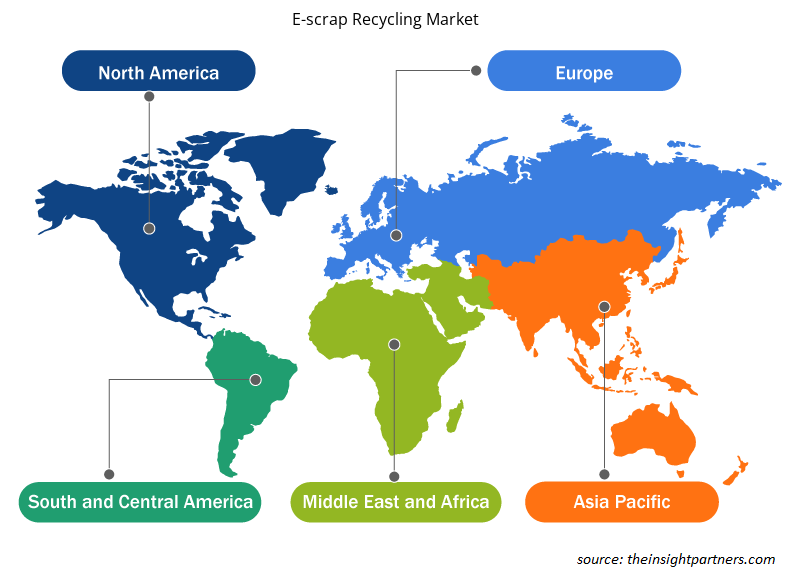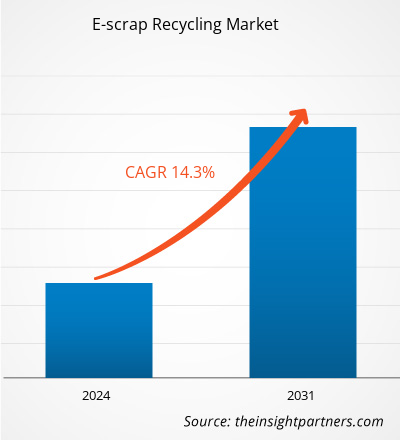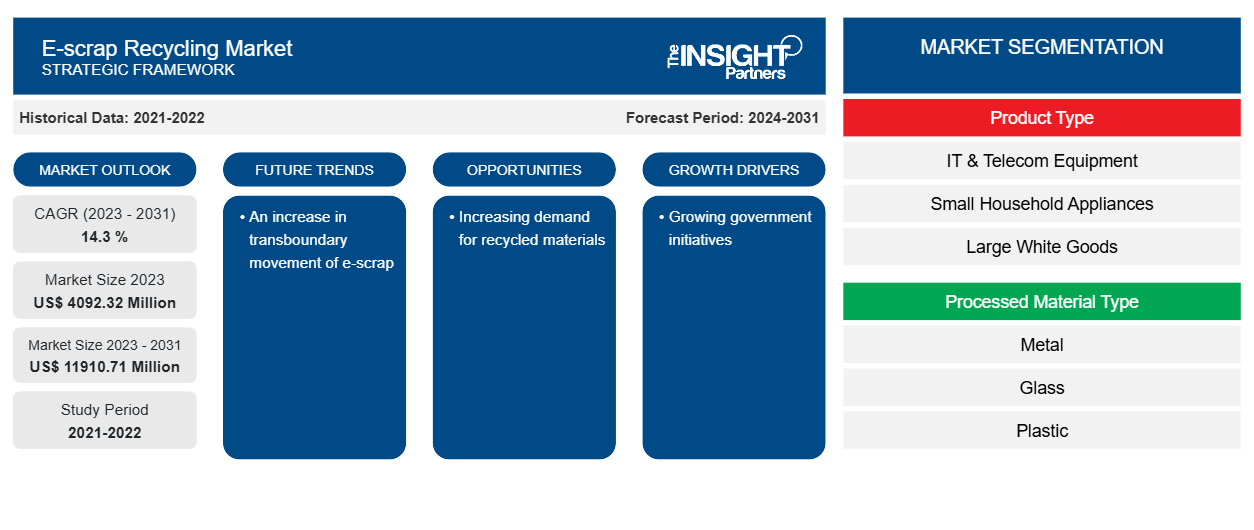Se proyecta que el tamaño del mercado de reciclaje de chatarra electrónica alcance los 11 910,71 millones de dólares estadounidenses en 2031, frente a los 4092,32 millones de dólares estadounidenses en 2023. Se espera que el mercado registre una CAGR del 14,3 % durante el período 2023-2031. Es probable que el aumento del movimiento transfronterizo de chatarra electrónica siga siendo una tendencia clave en el mercado.
Análisis del mercado de reciclaje de chatarra electrónica
Los fabricantes de electrodomésticos también están ofreciendo modelos más nuevos para atraer a los clientes. Los lanzamientos de nuevos productos preceden al desguace de los electrodomésticos existentes , lo que beneficia a los actores del mercado del reciclaje de chatarra electrónica. Esto está transformando nuevamente la industria del reciclaje de chatarra electrónica. Además, a medida que los avances tecnológicos avanzan rápidamente en todo el mundo, los fabricantes de productos electrónicos de consumo o electrodomésticos con una vida útil limitada. Esto ayuda a los fabricantes a aumentar sus tecnologías con el tiempo, lo que resulta en una disminución en la cantidad de depósitos de chatarra electrónica, lo que en última instancia impulsa el mercado del reciclaje de chatarra electrónica.
Descripción general del mercado de reciclaje de chatarra electrónica
El reciclaje de desechos electrónicos es el método de extraer elementos valiosos después de eliminarlos en pequeñas piezas que podrían reciclarse en un nuevo aparato electrónico. El reciclaje de desechos electrónicos tiene todo tipo de beneficios, incluida la protección del medio ambiente y la salud humana. La mayoría de los materiales que componen los teléfonos inteligentes y las computadoras se derivan de minerales no renovables; el reciclaje de estos materiales puede evitar que el suministro de bienes de consumo que se vuelven inevitables en nuestras vidas se suspenda hasta que se descubran sustitutos.
Personalice este informe según sus necesidades
Obtendrá personalización en cualquier informe, sin cargo, incluidas partes de este informe o análisis a nivel de país, paquete de datos de Excel, así como también grandes ofertas y descuentos para empresas emergentes y universidades.
-
Obtenga las principales tendencias clave del mercado de este informe.Esta muestra GRATUITA incluirá análisis de datos, desde tendencias del mercado hasta estimaciones y pronósticos.
Factores impulsores y oportunidades del mercado del reciclaje de chatarra electrónica
Crecientes iniciativas gubernamentales
Los gobiernos de varios países están tomando iniciativas para el reciclaje de chatarra electrónica. El gobierno ha llevado a cabo una serie de pasos para formalizar el sector de reciclaje de desechos electrónicos en varios países. Las normas de gestión de desechos electrónicos establecen la autorización obligatoria de las unidades de demolición y reciclaje por parte de las Juntas Estatales de Control de la Contaminación (SPCB) o los Comités de Control de la Contaminación (PCC). La CPCB ha emitido directrices para el procesamiento de desechos electrónicos. La CPCB y las SPCB han estado observando las unidades y se han tomado las medidas necesarias para mejorar y modernizar la industria del reciclaje con la ayuda del Ministerio de Electrónica y Tecnología de la Información. Por lo tanto, las crecientes iniciativas gubernamentales están impulsando el mercado del reciclaje de chatarra electrónica.
Creciente demanda de materiales reciclados
Los consumidores están muy satisfechos con los productos fabricados con materiales reciclados que, además, son ecológicos al final de su vida útil. En una encuesta realizada a una empresa, una gran mayoría supuso que los productos fabricados con materiales reciclados son superiores a los fabricados con materiales vírgenes. Los consumidores de todo el mundo se han preocupado cada vez más por los residuos de envases y las fugas al medio ambiente, y los gobiernos han empezado a responder al sentimiento público con medidas contundentes a lo largo de plazos acelerados, por lo que la demanda de materiales reciclados está aumentando, lo que está creando más oportunidades para el mercado.
Análisis de segmentación del informe de mercado de reciclaje de chatarra electrónica
Los segmentos clave que contribuyeron a la derivación del análisis del mercado de reciclaje de chatarra electrónica son el componente, el protocolo y la aplicación.
- Según el tipo de producto, el mercado de reciclaje de chatarra electrónica se divide en equipos de TI y telecomunicaciones, pequeños electrodomésticos, electrodomésticos grandes, productos electrónicos de consumo y otros. El segmento de equipos de TI y telecomunicaciones tuvo una mayor participación de mercado en 2023.
- Por tipo de material procesado, el mercado está segmentado en metal, vidrio, plástico y otros.
Análisis de la cuota de mercado del reciclaje de chatarra electrónica por geografía
El alcance geográfico del informe del mercado de reciclaje de chatarra electrónica se divide principalmente en cinco regiones: América del Norte, Asia Pacífico, Europa, Medio Oriente y África, y América del Sur y Central.
La región APAC domina el mercado del reciclaje de chatarra electrónica. Diversos factores impulsan este mercado, como las crecientes iniciativas gubernamentales, la creciente demanda de materiales reciclados y otros. Por lo tanto, el mercado está creciendo significativamente en la región.
Perspectivas regionales del mercado de reciclaje de chatarra electrónica
Los analistas de Insight Partners explicaron en detalle las tendencias y los factores regionales que influyen en el mercado de reciclaje de chatarra electrónica durante el período de pronóstico. Esta sección también analiza los segmentos y la geografía del mercado de reciclaje de chatarra electrónica en América del Norte, Europa, Asia Pacífico, Oriente Medio y África, y América del Sur y Central.

- Obtenga datos regionales específicos para el mercado de reciclaje de chatarra electrónica
Alcance del informe de mercado sobre reciclaje de chatarra electrónica
| Atributo del informe | Detalles |
|---|---|
| Tamaño del mercado en 2023 | US$ 4092,32 millones |
| Tamaño del mercado en 2031 | US$ 11.910,71 millones |
| CAGR global (2023 - 2031) | 14,3 % |
| Datos históricos | 2021-2022 |
| Período de pronóstico | 2024-2031 |
| Segmentos cubiertos |
Por tipo de producto
|
| Regiones y países cubiertos |
América del norte
|
| Líderes del mercado y perfiles de empresas clave |
|
Densidad de actores del mercado: comprensión de su impacto en la dinámica empresarial
El mercado de reciclaje de chatarra electrónica está creciendo rápidamente, impulsado por la creciente demanda de los usuarios finales debido a factores como la evolución de las preferencias de los consumidores, los avances tecnológicos y una mayor conciencia de los beneficios del producto. A medida que aumenta la demanda, las empresas amplían sus ofertas, innovan para satisfacer las necesidades de los consumidores y aprovechan las tendencias emergentes, lo que impulsa aún más el crecimiento del mercado.
La densidad de actores del mercado se refiere a la distribución de las empresas o firmas que operan dentro de un mercado o industria en particular. Indica cuántos competidores (actores del mercado) están presentes en un espacio de mercado determinado en relación con su tamaño o valor total de mercado.
Las principales empresas que operan en el mercado de reciclaje de chatarra electrónica son:
- Compañía de holdings Dowa Ltd.
- Ecoreco Ltd.
- Recicladores electrónicos internacionales Inc.
- Enviro-Hub Holdings Ltd
- Corporación minera y metalúrgica JX Nippon
- Gestión de metales Sims Ltd.
Descargo de responsabilidad : Las empresas enumeradas anteriormente no están clasificadas en ningún orden particular.

- Obtenga una descripción general de los principales actores clave del mercado de reciclaje de chatarra electrónica
Noticias y desarrollos recientes del mercado de reciclaje de chatarra electrónica
El mercado de reciclaje de chatarra electrónica se evalúa mediante la recopilación de datos cualitativos y cuantitativos a partir de una investigación primaria y secundaria, que incluye importantes publicaciones corporativas, datos de asociaciones y bases de datos. A continuación, se enumeran algunos de los avances en el mercado de reciclaje de chatarra electrónica:
- El gobierno creará pronto una plataforma en línea para facilitar el comercio de certificados de Responsabilidad Extendida del Productor (REP). Esta medida ayudará al país a hacer frente a la creciente amenaza de los desechos electrónicos, como los teléfonos móviles y los ordenadores portátiles fuera de servicio. (Fuente: Responsabilidad Extendida del Productor (REP), comunicado de prensa, marzo de 2024.)
- Los principales fabricantes de productos electrónicos se unieron esta semana a la Asociación de Tecnología del Consumidor para formar la Iniciativa de Circularidad de Tecnología del Consumidor, cuyo objetivo era impulsar el procesamiento de desechos electrónicos, mejorar la reparación y la reutilización e incorporar más contenido reciclado en los productos. (Fuente: Asociación de Tecnología del Consumidor, comunicado de prensa, enero de 2024)
Informe sobre el mercado del reciclaje de chatarra electrónica: cobertura y resultados
El informe “Tamaño y pronóstico del mercado de reciclaje de chatarra electrónica (2021-2031)” proporciona un análisis detallado del mercado que cubre las siguientes áreas:
- Tamaño del mercado de reciclaje de chatarra electrónica y pronóstico a nivel mundial, regional y nacional para todos los segmentos clave del mercado cubiertos bajo el alcance
- Tendencias del mercado de reciclaje de chatarra electrónica, así como dinámica del mercado, como impulsores, restricciones y oportunidades clave
- Análisis detallado de las cinco fuerzas de Porter y PEST y FODA
- Análisis del mercado de reciclaje de chatarra electrónica que abarca las tendencias clave del mercado, el marco global y regional, los principales actores, las regulaciones y los desarrollos recientes del mercado
- Panorama de la industria y análisis de la competencia que abarca la concentración del mercado, análisis de mapas de calor, actores destacados y desarrollos recientes en el mercado de reciclaje de chatarra electrónica
- Perfiles detallados de empresas
- Análisis histórico (2 años), año base, pronóstico (7 años) con CAGR
- Análisis PEST y FODA
- Tamaño del mercado, valor/volumen: global, regional y nacional
- Industria y panorama competitivo
- Conjunto de datos de Excel
Informes recientes
Testimonios
Razón para comprar
- Toma de decisiones informada
- Comprensión de la dinámica del mercado
- Análisis competitivo
- Información sobre clientes
- Pronósticos del mercado
- Mitigación de riesgos
- Planificación estratégica
- Justificación de la inversión
- Identificación de mercados emergentes
- Mejora de las estrategias de marketing
- Impulso de la eficiencia operativa
- Alineación con las tendencias regulatorias























 Obtenga una muestra gratuita para - Mercado de reciclaje de chatarra electrónica
Obtenga una muestra gratuita para - Mercado de reciclaje de chatarra electrónica